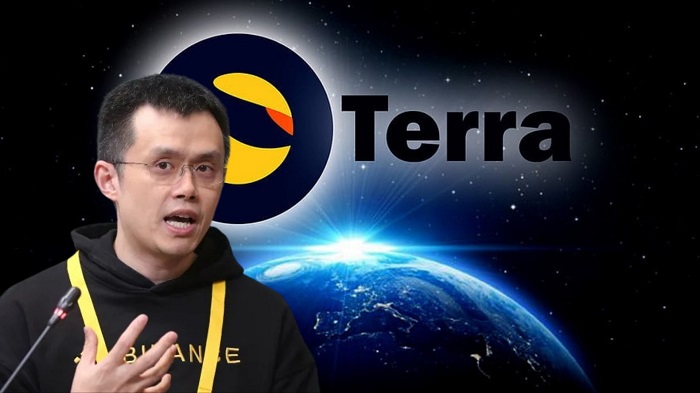Changpeng Zhao: 7-point summary and 3-point suggestions on the UST/LUNA crash
This article comes fromBinance Blog, original author: Zhao Changpeng
Odaily Translator |

This article comes from
, original author: Zhao Changpeng
Odaily Translator |
Binance CEO Changpeng Zhao published an article on the official blog explaining the lessons learned from the UST/LUNA crash. The full text is as follows:Twitter In fact, every interview I've ever been to, I've talked about it more or less. To further clarify my thinking on this topic, here is a summary, including personal views, lessons learned, spillover effects, systemic risk, market resilience, regulations, and more.
The UST/LUNA debacle was indeed a sad event that affected many people. At Binance, our top priority is to protect every affected user. Sadly, it is difficult to find a solution that pleases everyone, and while many proposals have been discussed by the community, each of them unfortunately has drawbacks. I was
It has publicly expressed its views on this matter, and Binance has also volunteered to let the Terra project team focus on helping retail investors.
secondary title1. Design flawsFirst, let's look at the design flaws of UST/LUNA.
In theory, when using different assets as collateral to peg to one asset, there is always the possibility of undercollateralization or unpegging. Even if overcollateralized by 10 times, the mortgage assets may have more than 10 times the risk of collapse.
Nothing in this world is 100% stable
● The biggest design flaw of UST/LUNA is that it thinks that minting more assets will increase its total value (market value). Printing money will not create value, it will only dilute the value of TOKEN in the hands of holders, minting LUNA at an exponential rate will make the problem worse, so those who design UST/LUNA should figure this out first.
● Another design flaw of UST/LUNA is that it provides too aggressive incentives. Specifically, the 20% fixed annualized rate of return offered by Anchor Protocol drove too much "inorganic growth." We should not only see the superficial vanity, but pay more attention to the fundamentals. Of course, you can use incentives to attract users to the ecosystem, but ultimately you need to generate "revenue" to stay afloat, simply having more income than you spend. Otherwise, your funds will run out and eventually collapse.
However, under the UST/LUNA model, the concept of "revenue" is confused, and the project team may use their own token sales or token appreciation as "revenue", which is obviously flawed. People are drawn to Anchor Protocol because of the high-yield incentives offered by the protocol. Yes, under the stimulation of high returns, the valuation of LUNA has been pushed up, and it has also attracted many investors to enter the market, but the more people are attracted, the more incentives will be given, and you have not yet created any value.
2. High income does not necessarily mean that the project is healthy
UST/LUNA is built on a superficial notion of self-perpetuation, and while Terra does have an ecosystem with some use cases, the growth rate of this ecosystem simply does not match the growth rate of the incentives used to attract new users. Growth is "hollow" and eventually, the bubble bursts and we get hurt.
Key lesson: Don't just go for high yields, look at fundamentals.
secondary title3. The method of trying to restore the UST anchor is wrong
The Terra team wanted to use their reserves to restore the UST peg, but the execution was too slow. If they had tapped their reserves when the decoupling rate hit 5%, the whole crash could have been avoided. But they only tried to use the $3 billion reserve fund to rescue after the token value plummeted by 99% (about $80 billion)-no doubt, at this time, there was no way to recover.You see, the Terra team looks a bit dumb (sorry for lack of a more polite word), and the lesson learned here is:
On the other hand, the Terra team's communication with the community is also very slow and infrequent, which further erodes users' trust in them. so,
Always communicate frequently with your users, especially in times of crisis.
In the end, I have mixed feelings about the revival plan offered by the Terra team. But as I said, regardless of my personal feelings, we stand firmly behind the community's decision.
secondary title
of course!
In fact, the timing of the UST/LUNA crash had a huge impact on the entire crypto ecosystem. USDT once decoupled from 0.96, but recovered quickly. Many crypto projects have also been negatively impacted in many ways, and unsurprisingly, the prices of most cryptocurrencies have dropped, even the price of Bitcoin has dropped by about 20%.
Many people lose money from high-yield projects, but if you think about it, it might not be such a bad thing in the long run. Some shocks in the market are conducive to further consolidating the foundation of the industry, and to some extent will also "benefit" other more reliable projects. For example, the BUSD pegged exchange rate has always remained at 1.1, and capital inflows have been maintained in the past few weeks.
secondary title
5. The crypto ecosystem remains resilient
The UST/LUNA crash was bigger than Lehman Brothers, but Bitcoin only dropped about 20% from $40,000 to $30,000. Overall, most crypto projects are doing well.
For people who are used to centralized systems, it can be difficult to understand the advantages of resilience that decentralized systems offer. In a centralized system, all banks operate similarly (they are required to do so by regulation), they all take reserves from the central bank, and when one bank fails, there are spillover effects on all other banks. In a decentralized system, all stablecoins work in different ways and there is no common standard or reserve, so even if one stablecoin fails, the impact on other stablecoin projects will not be too great.
Even without the bailout, other major stablecoins in the crypto market have weathered the shock, and most other crypto projects have done well.
secondary title
I don't know what every regulator is going to think or do.
So far, from what I've heard from the few people I keep in regular contact with, most of the regulatory response has been positive. Of course, the responses I've heard may have been one-sided, as most of the people I've been in close contact with have been very crypto-friendly. However, I do believe we need more guidelines on how to regulate stablecoins, as one regulator put it this way:
“We certainly need to pay more attention to algorithmic stablecoins, but we can’t kill the entire industry because of one company that fails, but should continue to move forward.”
secondary title
7. How to avoid similar systemic risks in the future?
Actually, it's a "trillion dollar" question.
I don't think there's an absolute answer yet, because everything has risks, and so does the fiat money you use today. The British pound is the oldest currency in use today, but it has only existed for less than 330 years, and all previous currencies have disappeared. We could of course ban or shut down everything, but that would also stifle innovation. Banks fail and there is mismanagement, but we are not going to close all the banks.
In the final analysis, we can try to reduce systemic risk. Here are three suggestions:
● As an investor, you need to diversify your investment portfolio and don't put all your savings in one basket, even if a certain project offers high returns.



